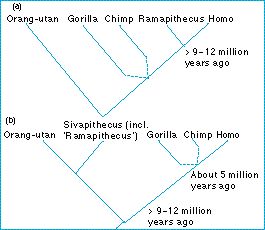The reconstruction of phylogeny - What happens when morphological and molecular methods clash?

A controversy: human origins
It is interesting when there is a conflict between older fossil evidence and more recent molecular evidence. An example of this concerns the time of origin of the human evolutionary lineage:
We can consider the fossil evidence first: 'Ramapithecus' is a group of fossil apes that lived about 9 - 12 million years ago. Until the late 1960s, almost all paleoanthropologists thought that Ramapithecus was a hominid: that is, it was more closely related to Homo than to chimpanzees and gorillas.
Ramapithecus and Homo shared a number of derived characters:
1. Homo has a rounded, 'parabolic' dental arcade, whereas chimps have a more pointed dental arcade, and Ramapithecus's was initially thought to be shaped more like Homo .
2. Ramapithecus's canine teeth were thought to be relatively diminished compared with its other teeth, as in Homo but unlike chimps in which the canines are large.
3. Homo and Ramapithecus were thought to share, as a derived condition, a thickened layer of tooth enamel, unlike the thinner layer in other apes.
It was a classic morphological argument: a set of character states are shown to be shared uniquely by these two species and the characters are derived within the larger group of Hominoidea. The paleontological conclusion was that of figure (a): the human lineage must have split from the great apes at least 12 million years ago, because Ramapithecus is nearer to us than to the great apes.
Figure: relationships of Homo, other great apes and Ramapithecus according to (a) paleontological and (b) molecular (and revised paleontological) evidence. Dotted lines imply uncertainty.
| Next |



